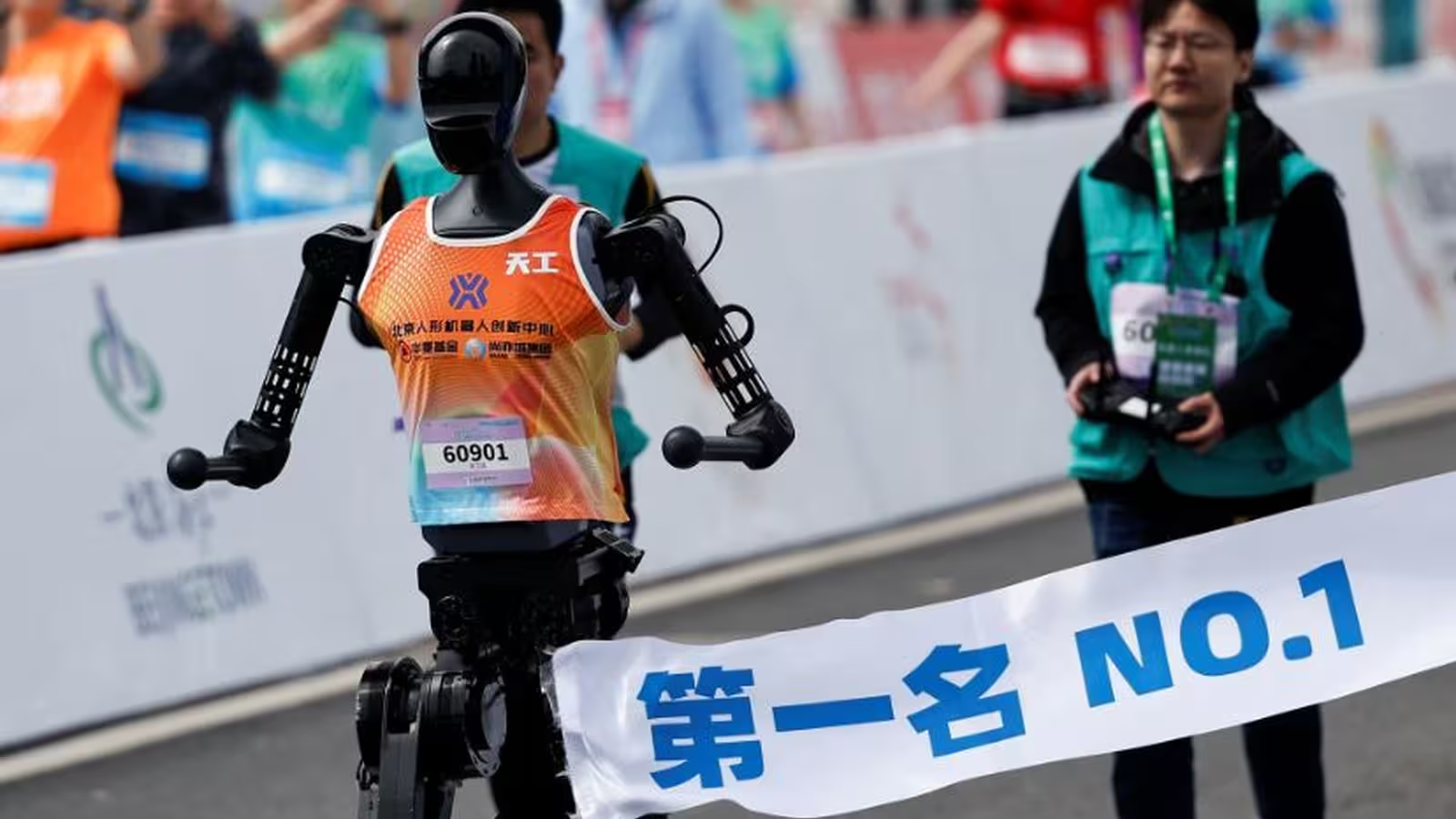7 Minutes
The Persistent Challenge: Powering Next-Gen Robots
From high-tech humanoids to agile robotic dogs, modern robotics has achieved extraordinary feats in locomotion, dexterity, and artificial intelligence. Yet, no matter how stunning their movements or complex their tasks, advanced robots share one fundamental limitation: insufficient energy endurance. The "robot energy crisis" is now one of the key bottlenecks in unlocking the full potential of autonomous machines.
Consider a recent example: Earlier this year in Beijing, a robot completed a half marathon (21km) in under 2 hours and 40 minutes—a remarkable achievement, albeit far behind elite human runners. Notably, this robotic runner could not finish the race on a single battery charge, stopping three times for battery replacements along the route. While this fact may seem minor on the surface, it highlights a significant technological challenge: current robotic systems lack the energy storage capacity to operate continuously over extended periods, especially when compared to their biological counterparts.
Performance vs. Endurance: Where Robots Still Lag
Today's robots can sprint, leap, and climb with unprecedented agility, drawing on decades of research in biomechanics, motion control, and advanced actuators. Boston Dynamics' robots—like Spot and Atlas—can mimic animal movements and even surpass organic muscle efficiency in specific actions. However, when it comes to sustained operation and long-haul endurance, robots remain vastly inferior to living creatures. Animals get tired, but they also refuel seamlessly through food intake and rest; robots simply stop when their power runs out, regardless of how efficient or intelligent their movements may be.
Battery Limitations: The Core of the Energy Challenge
Most mobile robots rely on lithium-ion batteries—the same technology used in smartphones and electric vehicles. While reliable and accessible, lithium-ion cells are improving only incrementally: energy density increases by roughly 7% each year. At this pace, it would take more than a decade to double a robot's active runtime. For example, Spot, the quadruped robot from Boston Dynamics, operates for just 90 minutes per charge and requires another hour to recharge—far less than the working shift of a human or the days-long stamina of a sled dog.
The fundamental issue isn't just the robotics hardware; it's energy storage. Comparative metrics illustrate the disparity clearly: animal fat stores about 9 kWh of energy per kilogram, giving a sled dog the equivalent energy reserve of a fully-charged Tesla Model 3 (around 68 kWh). In contrast, lithium-ion batteries deliver a mere 0.25 kWh/kg. Even if robots use highly efficient actuators, matching animal endurance would require energy storage technologies dozens of times more powerful than what's currently available for robotics.
Operational Bottlenecks: Real-World Implications
This restricted autonomy isn't just a technical footnote—it determines which real-world missions robots can successfully undertake. A search-and-rescue robot that runs out of power after 45 minutes may fail to complete its operation. Agricultural robots needing charge every hour cannot scale for timely harvests. Even in logistics or hospital settings, short runtimes introduce logistical complexity and added cost. For robots to play critical roles in society—supporting the elderly, exploring hazardous environments, or collaborating with humans for extended periods—their energy systems must radically improve.
Beyond Lithium-Ion: Exploring Emerging Battery Technologies
Researchers are pushing boundaries with new chemistries such as lithium-sulfur and metal-air batteries, which theoretically offer much higher energy densities—some nearing animal fat levels. When paired with next-gen actuators, these batteries could enable robots to compete with, or even outperform, biological organisms in energy endurance. However, real-world limitations persist: these advanced batteries often degrade quickly, are hard to recharge, or introduce new engineering hurdles. Fast-charging can reduce downtime but shortens battery lifespan, generates heat, and demands heavy, powerful infrastructure—solutions that are problematic or unfeasible in field operations and remote deployments.
Harnessing Natural Inspiration: Robotic Metabolism and Artificial Nutrition
Since evolution has optimized biological energy management for millions of years, scientists look to nature for inspiration. Animals don't plug in to recharge; they ingest and metabolize food, storing energy efficiently as fat, circulating it via blood, and drawing on it as needed. Could robots emulate this approach through artificial nutrition and synthetic metabolism?
Robots That "Eat": Chemical Reactors and Distributed Energy Storage
Some innovative research teams are developing systems in which robots "digest" metals or chemical fuels, processing these substances with artificial stomach-like chemical reactors to generate electricity. For example, high-energy materials like aluminum can be transformed into electrical power, mimicking the digestive processes found in animals. Rather than relying on a single central battery, future robots might distribute energy reserves throughout their bodies, storing power in limbs, joints, or even in soft tissue analogs.
Bio-inspired Fluid Energy Systems: The Robotic Circulatory Revolution
Other approaches involve fluid-based energy networks, designed to mimic animal blood. A prominent prototype is the robotic fish that boosted its energy capacity threefold by flowing a multifunctional liquid—effectively acting both as actuator fluid and energy storage medium—through its system, rather than using a standard battery. This leap in design represented nearly 16 years' worth of battery technology progress overnight. Such systems promise not only longer uptime but also energy sourced from materials far more potent than conventional batteries.
In biological systems, energy isn't just for motion; blood also regulates temperature, transports hormones, and supports healing. Artificial metabolism might allow robots to self-cool, self-repair with stored or recycled materials, and dynamically allocate energy across their structures.

Comparing Energy Solutions: Batteries vs. Artificial Metabolism vs. Solar
A comprehensive view of robotics energy strategies includes:
- Traditional Lithium-Ion Batteries: Reliable and cost-effective, but with limited endurance and slow progress in energy density.
- Emerging Chemistries (Li-S, Metal-Air): Potential for major gains in storage, still held back by charging/longevity issues.
- Solar Energy: Effective for stationary or ultra-low-power robots in bright environments, but inadequate for most mobile operations requiring high power bursts.
- Artificial Nutrition/Bio-Inspired Metabolism: Transformative promise of distributed, flexible, and self-renewing energy supplies—mirroring biological advantages.
Each approach offers unique advantages and is likely to complement the others depending on specific robotic application domains.
Real-World Use Cases: Why Robotics Needs Better Energy Solutions
Robotic energy innovation isn't just about curiosity—it's integral to the future of multiple industries:
- Search and Rescue: Robots operating in disaster or remote zones must remain functional for hours or days without logistical support.
- Agriculture: Autonomous harvesters and drones require durable power for field coverage without frequent interruptions.
- Logistics and Warehousing: Long-lasting operation reduces recharging cycles, improving throughput and lowering maintenance complexity.
- Healthcare and Assisted Living: Service robots supporting the elderly or infirm can't afford unexpected downtime.
- Space Exploration: Robotics designed for lunar or Martian missions may need to "eat" local resources or use advanced batteries, given the absence of power infrastructure.
The competitive landscape is increasingly defined by which robotics platforms can maximize useful uptime while minimizing dependency on heavy infrastructure or manual intervention.
Market Relevance and the Path Ahead
As the market for autonomous robots grows—from warehouse automation to household helpers—the demand for robust, long-lasting energy systems will only intensify. Companies investing in battery R&D, chemical-energy converters, or bio-inspired circulatory mechanisms could gain a significant edge.
Moreover, distributed energy storage and "robotic metabolism" offer strategic resilience: machines capable of scavenging, digesting, or recycling fuel could operate in environments otherwise hostile to electronic-only solutions. As robotics takes on more complex roles in healthcare, security, agriculture, and beyond, the ability to mimic nature’s energy strategies becomes a crucial differentiator.
Key Product Features of Future Energy Systems for Robotics
- High Energy Density: Enables longer, uninterrupted missions even with compact form factors.
- Flexible Recharge/Fueling: Multiple replenishment options—batteries, solar, chemical fuels, or environmental scavenging.
- Distributed Storage: Enhanced redundancy, safety, and mechanical balance.
- Self-Repair and Thermal Management: Bio-inspired fluid systems could allow dynamic temperature regulation and damage mitigation.
- Modular Upgrades: Swap or refuel energy reservoirs without overhauling entire robots.
Conclusion: Beyond Intelligence and Agility, Robots Need Endurance
The robotics sector has made leaps in mobility, intelligence, and adaptability. However, real-world usefulness will increasingly be limited not by how swiftly or smartly robots move, but by how long they can keep going. If humans hope to coexist and collaborate with robotic systems meaningfully—in industry, homes, or on distant worlds—breakthroughs in energy management are paramount.
Whether through revolutionary batteries, artificial nutrition, autonomous energy scavenging, or a blend of all these advances, the next era of robotics will only be defined by those machines that combine brains and agility with true stamina. Endurance is not just a trait of champions; it’s the definitive feature for the robots that will transform our future.
Source: theconversation



Comments